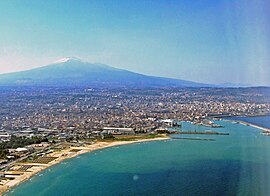Katane
| Catania | ||
|---|---|---|
| Comune | ||
| Comune di Catania | ||

Catania skyline
|
||
|
||
| Location of Catania in Sicily | ||
| Coordinates: 37°30′0″N 15°5′25″E / 37.50000°N 15.09028°ECoordinates: 37°30′0″N 15°5′25″E / 37.50000°N 15.09028°E | ||
| Country | Italy | |
| Region | Sicily | |
| Province / Metropolitan city | Catania (CT) | |
| Frazioni | San Giovanni Galermo | |
| Government | ||
| • Mayor | Enzo Bianco (PD) | |
| Area | ||
| • Total | 180.88 km2 (69.84 sq mi) | |
| Elevation | 7 m (23 ft) | |
| Population (1 January 2015) | ||
| • Total | 313,000 | |
| • Density | 1,700/km2 (4,500/sq mi) | |
| Demonym(s) | Catanesi | |
| Time zone | CET (UTC+1) | |
| • Summer (DST) | CEST (UTC+2) | |
| Postal code | 95100 | |
| Dialing code | 095 | |
| Patron saint | St. Agatha | |
| Saint day | February 5 | |
| Website | Official website | |
Catania (Italian: [kaˈtaːnja]) is an Italian city on the east coast of Sicily facing the Ionian Sea. It is the capital of the Metropolitan City of Catania, one of the ten biggest cities in Italy, and the seventh largest metropolitan area in Italy. The population of the city proper is 313,000 while the population of the conurbation is estimated to be 767,003. The metropolitan city has 1,115,310 inhabitants.
Catania is well known for its historical earthquakes, having been destroyed by catastrophic earthquakes in 1169 and 1693, and for several volcanic eruptions from the neighbouring Mount Etna, the most violent of which was in 1669.
Catania has had a long and eventful history, having been founded in the 8th century BC. In 1434, the first university in Sicily was founded in the city. In the 14th century and into the Renaissance period, Catania was one of Italy's most important cultural, artistic and political centres. The city has a rich culture and history, hosting many museums, restaurants, churches, parks and theatres. Catania is well known for its street food.
Catania is located on the east coast of the island of Sicily, at the foot of Mount Etna.
As observed by Strabo, the location of Catania at the foot of Mount Etna has been both a curse and a blessing. On the one hand, violent outbursts of the volcano throughout history have destroyed large parts of the city, whilst on the other hand the volcanic ashes yield fertile soil, especially suited for the growth of vines. (Strab. vi. p. 269)
Two subterranean rivers run under the city; the Amenano, which surfaces at one single point south of Piazza Duomo, and the Longane (or Lognina).
The ancient indigenous population of the Sicels named their villages after geographical attributes of their location. The Sicilian word, katane, means "grater, flaying knife, skinning place" or a "crude tool apt to pare". Other translations of the name are "harsh lands", "uneven ground", "sharp stones", or "rugged or rough soil". The latter etymologies are easily justifiable since, for many centuries following an eruption, the city has always been rebuilt within its black-lava landscape. Around 729 BC, the ancient village of Katane became the Chalcidian colony of Katánē where the native population was rapidly Hellenized. The Naxian founders, coming from the adjacent coast, later used the name for their new settlement along the River Amenano.
...
Wikipedia



